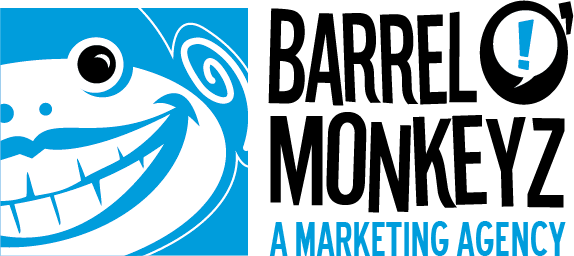SPEAKERS WANTED FOR AI TOPICS
San Diego, August 2024
Barrel O’Monkeyz is hosting an AI “experts” panel in early August in San Diego. We are looking for 2 to 3 AI experts to engage in a one-hour fireside chat about how AI can be used in the world of finance.
We plan to have 15 high profile CFOs from the San Diego area exchanging ideas, plus other CEOs, company presidents, and entrepreneurs in attendance.
Interested? If so, reach out to me, Paul June, at (310) 503-1149 or [email protected] .
Sometimes ideas just pop into our heads. Intuitively, we seem to know what to say or write about our product or service, or some incredible insight we want to share with the world. The ideas and words come freely, easily, as though they’re on auto-pilot.
Then there are other times when the ideas don’t flow or, if we have ideas, we can’t seem to find the words. This is what I call “content block.”
What Is Content Block?
Similar to writer’s block, when staring at a blank screen or empty sheet of paper sends even the most prolific of wordsmiths into a funk, content block is when you have something to sell, market, or communicate but you can’t come up with the words for your newsletter, blog, social media post, video, or presentation deck! There’s just nothing cooking, nothing leaping out at you saying, “talk/write about me.”
Content block can happen to anyone, anytime, whether you’re a marketing expert, sales professional, small business owner, or C-level executive.
Granted, if you work for a big company with its own marketing and communications team, or you outsource creative to an agency, you can turn to someone else when content block strikes. But if you’re a small business owner or entrepreneur who both runs the business as well as markets it, where do you turn when the idea spigot runs dry?
Here are some “tried and true” ideas you can use to overcome content block and keep the ideas coming:
Generating/Capturing Ideas
- How many times have you thought of some fantastic idea only to lose the notion later when you try to recall it? Problem solved: keep a journal, handwritten or digital (I use my smart phone to jot down notes). Many times, just the act of writing/typing something leads to additional ideas.
- Think of some tip or “how to” advice your target audience needs or wants and that you can deliver, then write out the steps, such as “10 steps to bringing your product to market.” It’s almost a sure thing that not only will you generate some good copy, but you’ll also spawn additional ideas.
- Review a product. It can either be yours or someone else’s you think your target audience is interested in: “I saw this product and here’s what I think.”
- Conduct a Q&A interview with a well-known expert in your field. You know the saying, “guilt by association?” Well, I believe in “success by association.” Interview this expert and write about it. Now your target audience suddenly sees you operating in the same space as this well-known person.
- Comment on something of relevance you’ve seen on social media, another Web site, in the news, etc. Discuss your reaction to it (positive or negative) and why your target audience should care.
- Repurpose your own content by taking an excerpt from your existing presentations, articles, or books. This is a great way to update and get new life out of old material.
- Relate a personal story or anecdote connected to your field of expertise, a “lesson learned” moment you want to share.
- Make a “Top 10” list (or “Top 7” or “Top 5”), such as the “Top 5 reasons ‘xyz’ happens” or the “Top 10 ways people use (your product).” Ranked lists are fun because they offer readers a chance to compare their rankings with yours, to validate their own thinking, or to open up discussion about what you’ve included vs. what they would have included.
- Get great sales copy straight from your current customers and/or colleagues who know you well. Ask them either in-person or through an email or online survey (Google Forms, anyone?) for verbatim comments so that you get a flavor of what people like about you and your product or service and how they might describe you to others. Often, you will find great language for sales and marketing copy—and at the very least, you will gain insight into what your target audience and colleagues perceive to be your strengths and weaknesses.
- If all else fails, log in to ChatGPT or similar and ask the AI bot to help generate some ideas. Often this can get your own creative juices flowing.
Tips for Developing Content
Blogs/Social Media/Videos
- Readers of your blog or social media posts expect the writing to be informal and conversational. You’ll want to use proper English, but not be “stuffy.” Generally, you’ll want to write in first person (“I” and “You”) and speak to readers as though you are talking to them one-to-one.
- Copy should be informational, not promotional. You also want to offer value to your readers, to position you/your company as credible expert in your particular field.
- Try to stick to one topic per entry. For blogs, aim for 800 +/- words. For social media, entries should be MUCH shorter, preferably with a link to where a full story can be found.
- Try to include pictures, video, or audio to add variety and to appeal to different learning/communications preferences.
Press Releases
- News content should be objective, not promotional. Don’t just “news-ify” your advertising copy. Consider your audience. Your first hurdle is the news editor. He or she must gauge whether what you are touting is newsworthy and of interest to his or her readers.
- The first paragraph of your copy should tell the whole story. Concisely describe what’s happened, who’s involved, and the impact on readers, preferably in three sentences or less, and be sure to mention your company or service. The rest of the article can flesh out the story with details and quotes.
Web/Sales Copy/Presentations
- Make an immediate emotional connection to your target audience. Speak to their “pain” or motivation—why they visited your Web site, picked up your brochure, or came to your presentation—and the need they want you to satisfy.
- Help them “see” themselves—or who they want to become—in the words. Help them “see” the benefit (i.e. increase profits, save money, gain more clients, become more productive, etc.)
- Demonstrate empathy—YOUR unique understanding of their needs, issues, and wants. In other words, you’ve been there, you’ve already solved their challenge, etc.
- In one or two sentences, present YOURSELF as credible, citing relevant credentials, expertise, and experience. We’re not talking about including your CV, but rather 2 or 3 relevant credentials, such as “nationally-known speaker and best-selling author.”
- Make a “call to action.” Provide a simple low-risk, low-price way for your audience to connect with you: offer a free e-newsletter, complimentary “get-to-know-you” session, low-cost product or service, or simply ask for them to contact you for more information.
Let’s Get Creative
Let Barrel O’Monkeyz act as your seasoned, outsourced marketing and creative team. Our barrel is full of talent and creative minds ready to prove we don’t just monkey around! Contact Barrel O’Monkeyz Today
.

